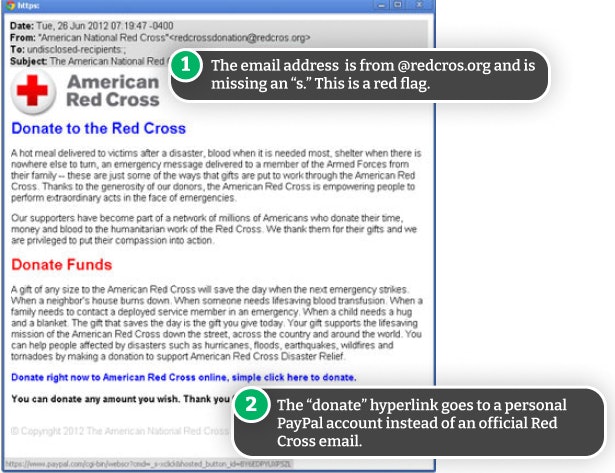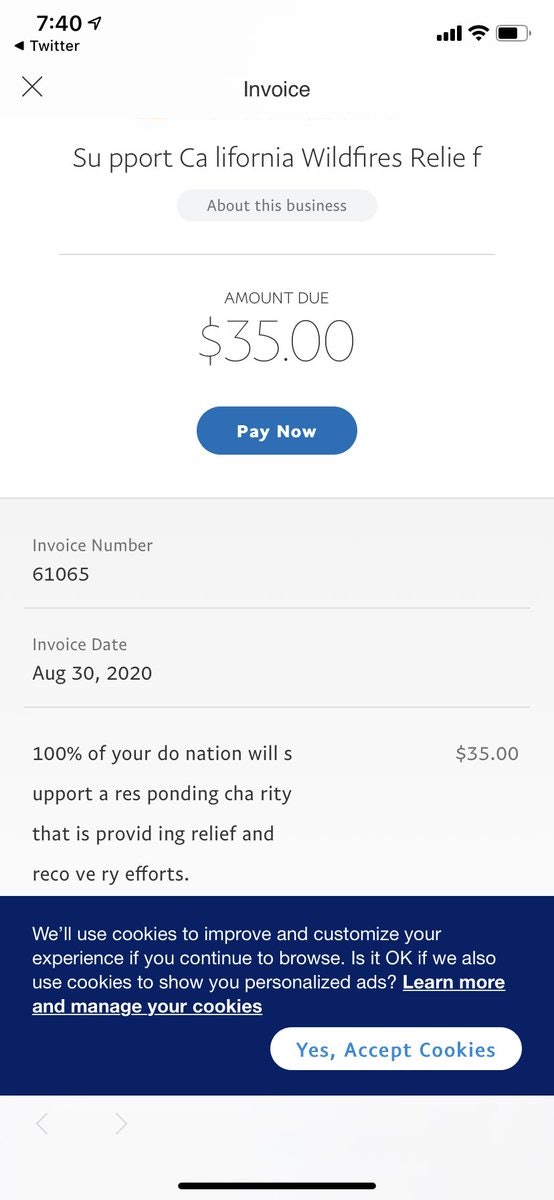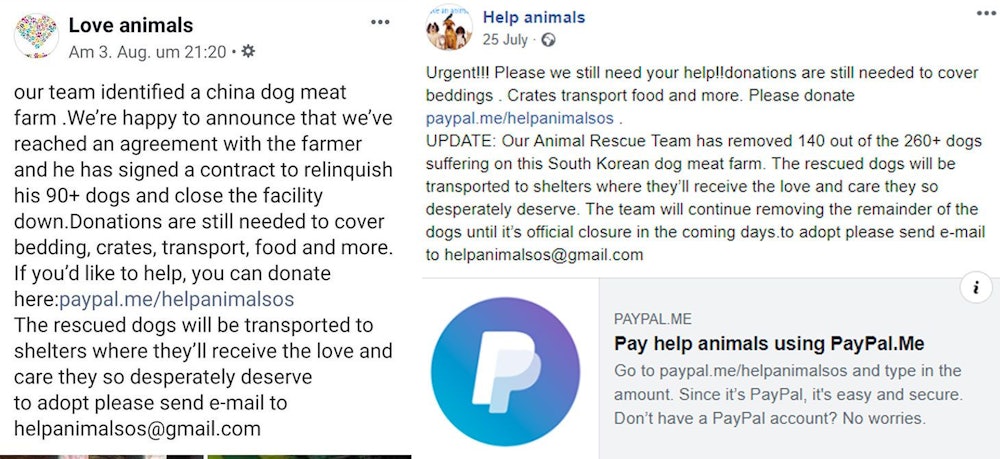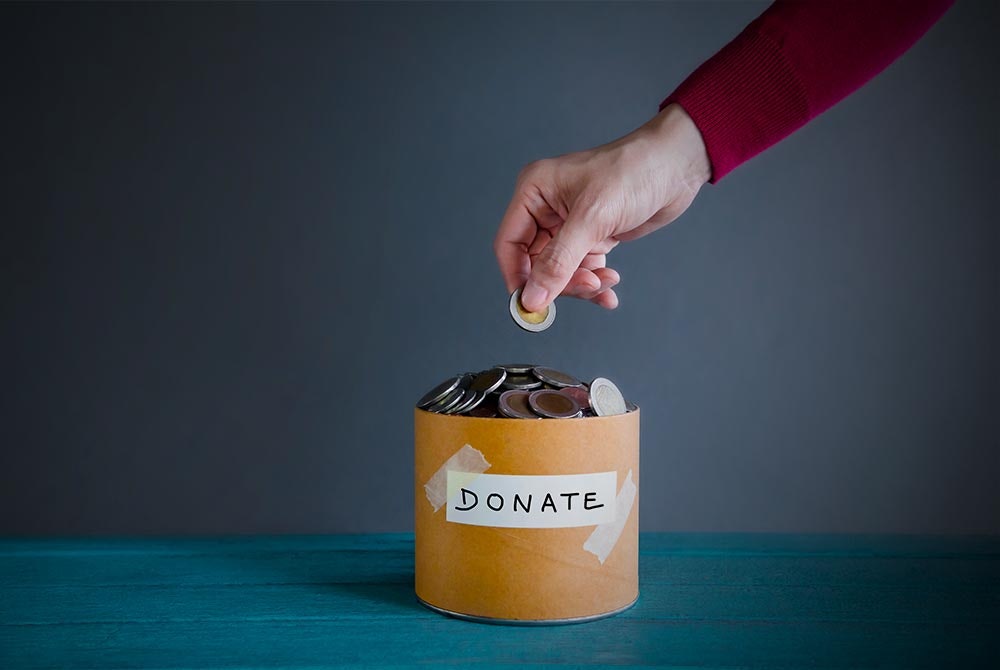- What Are PayPal Charity Scams?
- Red Flags of PayPal Charity Scams
- How to Beat PayPal Charity Scams
- Have You Fallen For PayPal Charity Scams?
- Frequently Asked Questions
It's common for legitimate charities to accept donations via PayPal. Unfortunately, scammers have taken advantage of this and unleashed PayPal charity scams to steal your money. Before donating to any charities, be sure you do your research to make sure you're donating to a genuine organization.
What Are PayPal Charity Scams?
In PayPal charity scams, you receive or view a plea for donations that appears as though they’re from a legitimate charity. The charity will likely mention that it benefits a well-known and popular cause—such as victims of a natural disaster, refugees, or terrorist attacks. The message will direct you to donate using your PayPal account.
However, when you click to donate through PayPal, your money will end up in the hands of a scammer–not the charity that you believed you were supporting. Here's how the PayPal charity scam works.
You’re Asked to Donate to a Charity
The PayPal charity scam can show up in several forms. You may receive an unsolicited email from someone claiming to work for a charity and seeking donations via PayPal. Or you may view a Facebook page set up to help victims of wildfires or floods, for example, that includes a link to donate using PayPal.
In a much more aggressive development, scammers are updating their techniques and emailing a fake charity PayPal receipt to people from charitable organizations. Users report receiving invoices for $35 from PayPal to support organizations such as the California Wildlife Relief Fund and WHO. The bogus invoices actually come from PayPal, which adds to the confusion.
Example Fake Charity PostUrgent!!! Please we still need your help!! Donations are still needed to cover beddings for the 260+ pets that need shelter and a home. Please donate via PayPal.
You Click on the PayPal Charity Link to Donate
You click on the link to either donate or pay the donation invoice, where you can enter your personal information and the amount of your donation. Clicking the payment button confirms a successful PayPal transfer of funds to the fake charity.
The Scammer Takes Your Funds
Your money is now in the hands of a scammer instead of a charity. Since the scammer has successfully targeted you, there’s a risk that you may be the victim of future scams regarding PayPal and fake charities. If you have given out any personal information, such as your address or phone number, the scammer now has access to that as well. Your other accounts may not be secure either.
Red Flags of PayPal Charity Scams
Scammers are always adapting their techniques to take advantage and cash in on the latest disaster or well-known cause. But once you know what to look for, PayPal fake charities may be easy to spot. These are the red flags to watch out for:
- Messages with grammatical and spelling errors
- Very limited or no online presence
- Time pressure to donate
- Receiving bills or messages acknowledging donations you didn't make
- Charity names sound similar to reputable organizations
As scammers get more advanced, these scams may be harder to spot, so it's essential to do your research on the charity first and only donate from official links found on their websites.
One way to spot a PayPal fake charity scam is to thoroughly read the message contents and the sender. In this email example, the sender is from redcros.org, an obvious misspelling and attempt to mimic the American Red Cross.

Deadline on Donations
Time pressures are another red flag. PayPal fake charity scammers might claim there is a limited amount of time to donate due to the severity of the situation. Real charitable organizations will not rush you into making donations.
Notification of a Donation You Didn’t Make
Receiving a fake charity PayPal receipt or message acknowledging your donation is another tell-tale sign of a scam. If you never donated to this organization, this message or invoice is only trying to take your money.
Messages Rife with Grammatical and Spelling Errors
Messages from fake charities tend to have spelling and grammatical errors and use strange spacing or statements. Genuine charities will have done their due diligence and, at the very least, would have done spell check before sending out their email or posting on their social media platform.
Scammers also may send fake charity PayPal invoices indicating you owe something for a contribution you did not make. The emails will look like they come from PayPal but may use strange statements or include grammatical and spelling mistakes.
Typos and grammatical errors aren't sure signs of a scam, however, so be sure to look for other red flags.

Limited or No Online Presence
Many times, if you Google the fake charity asking for support, you will not find the website or any other mentions of its work online. If they do have a website, it may have only minimal information.
You might also stumble on another popular PayPal fake charity scam by browsing Facebook pages. Fake charity scammers tend to use over-the-top, sensationalized descriptions to draw sympathy and bring in donations. Their messages also tend to be riddled with errors and look unprofessional—not what you’d expect from a respectable organization.

Not Listed as a Legitimate Charity
If the charity isn’t listed on a charity watchdog site like Charity Navigator, Charity Watch, or the Better Business Bureau, it’s most likely a fake charity.
Charity Names Mimicking Other Charities
You could receive a message claiming to be from a well-known organization, such as the WHO Relief Fund, but the scammer simply mimicks the name of legitimate charities. (In this case, the WHO Relief Fund combines the names of two different charitable entities, the World Health Organization and the COVID-19 Solidarity Response Fund.)
How to Beat PayPal Charity Scams
You might think you wouldn’t fall victim to a PayPal fake charity scam, but it’s possible. Scammers send persuasive messages and create legitimate-looking websites specifically designed to prey on your generosity and vulnerability. These scams tend to pop up when people are most likely to donate to philanthropic causes, such as in the aftermath of a natural disaster, terrorist attack, or refugee crisis.
To beat this PayPal fake charity scam:
- Do not click links asking for PayPal donations in emails, texts, social media pages, or websites without performing research first about the charity in question.
- Do not pay the invoice if you receive an invoice from PayPal claiming you owe funds to a charity.
- Contact PayPal to report a suspicious invoice, and if necessary, get the money back if it already left your account.
If You Click the Link
If you click the link to donate but do not enter your personal information or send any payments, don’t worry. You’re most likely safe. However, make sure to close the browser window and open a new window to search for the company’s actual website.
If you sent a payment to fake charities, contact PayPal immediately to report the scam and request a transaction cancellation. You may also need to notify your bank or financial institution (if you entered your bank or credit card details for the payment).
Unfortunately, PayPal's Buyer Protection Program doesn't cover donations, including donations to fake charities. You can still get your money back if the scammer hasn't claimed the transaction yet, but otherwise, there's no other way to get your money back.
Have You Fallen For PayPal Charity Scams?
If you’ve fallen victim to a PayPal charity scam, take the following steps to protect your personal information and recoup your funds:
- Report the scam to PayPal
- Change your passwords
- Contact your financial institution
- Report the scam to authorities
- Keep your accounts secure
Report the Scam to PayPal
If you have received a fake email from a charity that claims to accept donations through PayPal, forward it to [email protected] it can be investigated. If you find a scam that asks for donations via PayPal, visit PayPal’s Resolution Center to report the fraudulent activity (you'll need to sign in).
You can also use PayPal’s resolution center to dispute the transaction and ask them to return the funds.
Change Your Passwords
If you’ve clicked on any links or downloaded any attachments from a fake charity email, make sure you change the password of your PayPal account as well as your email, bank, and any other important passwords.
It's important to use strong and unique passwords for all of your accounts. If you're having trouble remembering all of your passwords, use a secure password manager.
Contact Your Financial Institution
Report the fraudulent transaction to your bank as soon as possible. They may request supporting documentation such as a copy of the email or message you received soliciting donations. The sooner you report to your bank, the better the chances of getting your money back.
Report PayPal Charity Scams to Authorities
Reporting the scam to authorities, such as your local police, the Federal Trade Commission (FTC), and the FBI, may not help you get your money back, but it will help fight scammers and raise awareness.


Comments